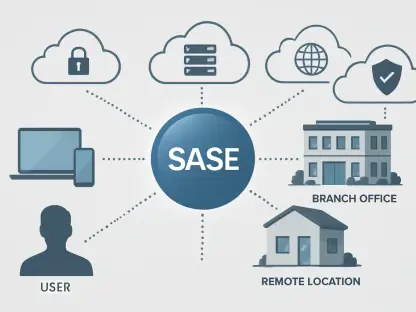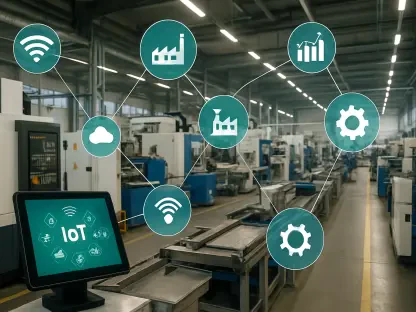In today’s fast-paced technological environment, data centers are the beating heart of digital activity, responsible for handling the ever-expanding volumes summoned by AI developments, cloud computing, and complex network services. As these demands intensify, the traditional frameworks guiding data centers have become obsolete, paving the way for more advanced solutions like event-driven automation (EDA). This transformative approach is reshaping network management by introducing enhanced adaptability, operational efficiency, and real-time responsiveness, promising a new era of stability and innovation. EDA redefines how data centers operate, shifting from a model of passive stability to one of proactive engagement, tailored for the dynamic demands of our interconnected world.
The Dynamics of EDA in Modernizing Data Centers
Data centers, long seen as bastions of stability, once thrived under the philosophy of “if it isn’t broken, don’t fix it.” However, the arrival of cloud computing and AI workloads necessitated an unprecedented reevaluation of this long-held wisdom. These innovations demand that networks not only hold their ground against disruptions but adapt and evolve in real-time to maintain seamless operations. Traditionally, the idea was to leave data center networks untouched to ensure their reliability. However, with AI applications requiring vast amounts of data to be processed instantly, this mindset shifted to one emphasizing continuous adaptation and active management.
Conventional network management practices often depended on periodic polling cycles, which struggled to keep pace with the immediacy demanded by today’s technology. When you consider the lag times inherent in these systems—often several minutes—the inefficiencies become glaringly apparent. This latency creates a visibility gap, risking untimely responses to critical network changes. The result could range from reduced operational efficiency to potentially devastating system outages. Hence, the push towards faster, more reliable solutions became inevitable, fueled by the rapid progression of technologies like AI and the heightened complexity of data center ecosystems.
With the advent of EDA, the landscape of network management sees a significant shift. Unlike traditional methods, EDA acts immediately upon detecting network events, bypassing the delays associated with polling cycles. This means real-time network data is accessible on-screen, enabling instantaneous issue identification and resolution. Such proactive responsiveness effectively reduces operational costs and extends the longevity of critical network infrastructure, marking a decisive move toward a more sustainable and efficient future. By facilitating this level of immediate action, EDA is changing the narrative, driving data centers toward a future-proof operational model that meets the demands of modern digital workloads.
Innovative Features Enhancing Data Center Operations
EDA doesn’t just strive for instantaneous action; it pushes the boundaries by incorporating sophisticated technologies such as digital twins and revision control systems. Digital twins represent a groundbreaking approach wherein a virtual replica of the network is created. This innovation allows for the simulation and testing of configurations in a risk-free environment, ensuring that any alterations are validated before affecting the live network. Consequently, data center engineers can explore various scenarios and solutions, mitigating risks linked to network modifications and avoiding crippling service disruptions.
Revision control further strengthens this proactive approach, providing networks the capacity to revert to any previous configuration state. This process is similar to rewinding a time machine for network settings, offering a safety net against unintended mishaps. The ease with which these rollbacks are executed drastically changes the risk profile associated with making network adjustments. It fortifies the cornerstone of operational security, equipping data center teams with unparalleled confidence and control as they navigate the complexities of evolving network infrastructures.
The role of Kubernetes cannot be understated in this transformative journey. Initially developed for Google’s internal hyperscale environments, Kubernetes acts as the engine driving EDA’s seamless scalability and management capabilities. This framework enables an abstraction from device-level configurations, encouraging a shift toward intent-based management that promotes efficiency. Separation from direct device interaction shifts the operator’s focus from granular configuration tasks to strategic oversight, optimizing network capabilities for higher-order computing functions. Such advancements highlight the technological strides data centers are making, driven by the necessity for enhanced scalability, agility, and robustness in facing the ever-growing demands of contemporary digital ecosystems.
Embracing Compatibility and Generational Shifts
The complexity of today’s data centers, characterized by diverse equipment from a myriad of vendors, demands versatile solutions that embrace multi-vendor compatibility. EDA meets this requirement head-on, offering solutions initially compatible with Nokia’s proprietary network operating systems and the open-source NOS SONiC. Plans for broader third-party support reflect an understanding of the heterogeneous nature of modern data center ecosystems, ensuring EDA’s relevance and utility across varied infrastructural setups. This adaptability is pivotal, enabling seamless integration and performance enhancement across diverse technological landscapes.
The field of network engineering is witnessing generational shifts, as seasoned professionals gradually retire and are succeeded by digital natives accustomed to intuitive, user-centric interfaces. EDA addresses these changes by integrating AI-driven operational interfaces that utilize natural language processing, moving away from the traditional command-line interfaces of yesteryear. This transition enhances accessibility and usability, ensuring the next generation of network engineers can continue steering data centers toward innovation. The ease of interaction also opens avenues for more dynamic, responsive management strategies that cater to the evolving expectations of modern network environments.
AI workloads introduce unique networking requirements, often diverging significantly from those needed for conventional computing tasks. These tasks demand robust infrastructures capable of supporting non-blocking fabric networks and comprehensive end-to-end control. EDA’s design includes flow-based visibility that precisely addresses these challenges, accommodating the intricacies of AI’s specific data processing needs. Ensuring compatibility and efficacy in handling AI workloads, EDA empowers data centers to meet these specialized demands head-on, maintaining their role as pivotal components in the digital transformation journey.
Intent-Based Networking and the Future of Automation
A notable shift in network management paradigms is embodied by intent-based networking (IBN). IBN focuses on achieving desired outcomes by shifting from device-specific configurations to an overarching, business-centric approach. This development ensures that network changes are thoroughly implemented, leaving no critical components unattended. This intent-driven model aligns network operations with broader business goals, facilitating comprehensive and cohesive configuration management that spans the entirety of the network landscape.
Looking ahead, the horizon for network automation is steadily expanding with emerging technologies like quantum computing and the anticipated rollout of 6G networks. These innovations necessitate even more advanced automation strategies that can effectively manage the intricate and vast landscapes of next-generation networking environments. EDA is well-positioned to evolve alongside these technology advancements, sustaining its crucial role as a cornerstone of resilient and adaptive network infrastructures. This evolution promises enhanced support for complex cloud, internet, AI, and communication systems, ensuring data centers remain agile, efficient, and unyielding amidst rampant technological change.
The consensus within the industry underscores the growing necessity for adaptive, intelligent network management solutions capable of navigating the intricacies brought on by advancements in AI and cloud computing. Traditional methods laden with latency fall short, highlighting the pivotal role of real-time, event-driven systems in bridging these gaps. By effectively turning the challenges of modern data center management into opportunities for innovation and efficiency, EDA has positioned itself as a transformative force, setting the stage for the future of network automation.
Transformative Outcomes of Event-Driven Automation
In today’s rapidly evolving technological world, data centers serve as the backbone of digital operations, managing the rising tide of information brought about by advancements in artificial intelligence, cloud computing, and intricate network services. As these demands grow, traditional data center models have become outdated, making room for innovative approaches like event-driven automation (EDA). EDA is revolutionizing network management by offering increased adaptability, operational efficiency, and instant responsiveness, heralding a new era of reliability and creativity. This approach transforms the functional framework of data centers, moving away from mere passive stability towards proactive engagement tailored to the dynamic needs of our interconnected society. EDA empowers data centers to act swiftly in real-time situations, adapting to unexpected changes efficiently and ensuring the uninterrupted flow of digital communication and services. By leveraging event-driven processes, data centers no longer simply react to problems but anticipate and address potential challenges before they escalate, fostering a more robust, resilient, and forward-thinking digital infrastructure that aligns with ever-changing global demands. This evolution in data center design represents a shift towards systems that emphasize agility and innovation, essential for thriving in today’s data-centric landscape.









